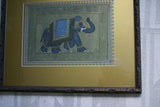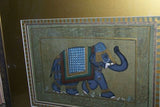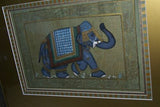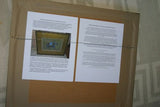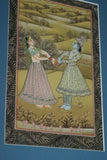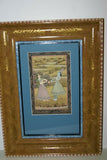ORIGINAL GONGBI MUGHAL ART BEAUTIFUL FRAMED LARGE PERSIAN INK MINIATURE PAINTING ON SILK FROM NEPAL EXTREMELY DETAILED RENDITION OF COURT ELEPHANT IN ORNATE GARB DFN12 DECORATOR DESIGNER COLLECTOR WALL ART HOME DECOR 23”X19”
ORIGINAL AUTHENTIC TRADITIONAL EXTREMELY DETAILED PERSIAN MINIATURE ART
INK PAINTING ON SILK
During the Song Dynasty, the art of Chinese Gongbi painting was at its peak
Purchased in the Kathmandu valley, Nepal, over 25 years ago and recently triple matted with acid-free mats (2 of them hand-painted with motifs to enhance the art and then framed in a carved wood frame)
Authentic, delicate and minute work
Ink painting of a Nepalese royal elephant
Item: DFN12
Measures: 23" X 19"
(Seen on all the pictures)
In these paintings the characters are always seen in profile AS IN EGYPTIAN ART.
Gongbi is a careful realist technique from China, the opposite of the interpretive and freely expressive xieyi (寫意 ‘sketching thoughts’) style and painted with a Chinese writing ink brush on Shu Xuan paper or silk that it is not permeable (for it has been covered by the glue and alum). .
The name is from the Chinese gong chin meaning ‘tidy’ (meticulous delicate precise detailed brush craftsmanship). The technique uses highly detailed brushstrokes that define details very precisely and without independent or expressive variation. It is often highly colored and usually depicts figural or narrative subjects.
The style had its beginnings approximately 2000 years ago during the Han Dynasty (206 BC - 220 AD) when Han's political stability and its prosperity favored the advancement of the arts. These paintings peaked out between the Tang and Song Dynasties (7th to 13th centuries) when these refined paintings were endorsed and collected by the royal families of China. The gongbi artists, to perfect this style, must totally commit themselves to these techniques. Only the wealthy could afford such artists. This style of art was accomplished in secret in royal palaces and private homes.
Mughal paintings were a unique blend of Indian, Persian and Islamic styles. Because the Mughal kings wanted visual records of their deeds as hunters and conquerors, their artists accompanied them on military expeditions or missions of state, or recorded their prowess as animal slayers, or depicted their sumptuous ceremonies of marriages. In this case, the royal elephant dressed for ceremonies is seen here.
Most Indian- Persian-Nepalese Miniature paintings were executed on a small scale with colored inks, to illustrate books.
The Palas of Bengal were the pioneers of miniature painting in India. The art of miniature painting reached its glory during the Mughal period.
This is a large rendition of such paintings
In eastern India, miniature painting developed in the 10th century. These miniatures were painted on the palm-leaf manuscripts as well as their wooden covers.
The books were called hastprat, written by hand, often relating love stories, and the ink paintings were placed there to make the subject of the book more pleasurable.
Mughal painting is the name of this miniature art created to illustrate books and which emerged, developed and took shape during the period of the Mughai Empire 16th −19th centuries.
They also depicted a number of themes, illustrating Classic Hindu epics like the Ramayana and the Mahabharata, Krishna's life, stories of the gods, beautiful landscapes, and popular folk stories. Creating the colors, extracted from certain minerals, plant sources, shells, etc… was a lengthy process, sometimes taking weeks. Brushes used were very fine.
We also carry original authentic prints 300 years old or less, framed or not, in great condition such as: Albin, Audubon, Baron, Barraband, Bertuch, Brodtmann, Brown, Buffon, Cassel, Curtis, Cuvier, Donovan, Edwards, Fitch, Frisch, Grandville, Harrison, Walter Hood, Latham, Linden,Linnaeus, Loddiges, Martinet, McKenney, Morris, Munting, Redoute, Reinchenbachia, Schreber, Schubert, Selby, Shaw and Nodder, Van Geel, Warner, etc.... etc...
Again, we closed our art store of antique prints and custom frames as well as our store of rare artifacts from around the world and we will now sell them direct to the public here. We have 1000's of antique prints and it will take a while to do so.














